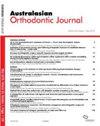Analysis of the growth of dental plaque on the surface of orthodontic vacuum-formed retainers following the use of different cleaning methods
IF 0.9
4区 医学
Q4 DENTISTRY, ORAL SURGERY & MEDICINE
引用次数: 0
Abstract
Abstract Background This study aimed to identify the most effective cleaning method for removable orthodontic clear vacuum-formed retainers (VFRs) and to assess the amount of dental plaque growth by microbiological analysis after performing mechanical, chemical and a combination of both cleaning methods. Methods The subjects were 23 patients from the Princess Nourah bint Abdulrahman University Dental Clinic who were in the retention phase of their orthodontic treatment using VFRs. The duration of the study was five weeks. Every week the subjects were given a new VFR and asked to wear it (20–22 hr/day) with instructions to use one of the following specific cleaning methods: running water, brushing with soap, immersing in sodium carbonate with sulphate cleaning solution, brushing with a fluoride toothpaste, and brushing with water. At the end of each week, the VFRs were returned, and a microbiological analysis was performed. Results At a statistically significant level, the highest bacterial concentrations were found on VFRs cleaned with running water compared to the other cleansing methods. There was no significant difference found in the bacterial count between brushing and toothpaste; brushing and soap, brushing and water, and tablet cleaning methods. Brushing with a fluoride toothpaste was the most effective method for cleaning the VFRs. Conclusion The findings of the present study indicate that cleaning VFRs with water alone is insufficient. Using chemical cleaning solutions and/or mechanical brushing significantly reduces the bacterial count on VFRs surfaces. Brushing with a fluoride toothpaste seems to be the most effective cleaning method for VFRs, given the limitations of the study.不同清洁方法对正畸真空固位器表面牙菌斑生长的影响
摘要背景本研究旨在确定可移除正畸透明真空成形固位器(VFRs)的最有效清洁方法,并在进行机械、化学和两种清洁方法的组合后,通过微生物分析评估牙菌斑的生长量。方法受试者为23名来自诺拉·宾特·阿卜杜勒拉赫曼公主大学牙科诊所的患者,他们正处于VFRs正畸治疗的保留期。研究持续时间为五周。每周给受试者服用一种新的VFR,并要求其佩戴(20-22小时/天),并说明使用以下特定清洁方法之一:自来水、用肥皂刷牙、用硫酸盐清洁溶液浸泡在碳酸钠中、用含氟牙膏刷牙和用水刷牙。每周结束时,返回VFR,并进行微生物分析。结果在统计学意义上,与其他清洁方法相比,用自来水清洁的VFR上的细菌浓度最高。刷牙和牙膏的细菌计数没有显著差异;刷牙和肥皂、刷牙和喝水以及药片清洁方法。用含氟牙膏刷牙是清洁VFR最有效的方法。结论本研究结果表明,单独用水清洗VFR是不够的。使用化学清洁溶液和/或机械刷显著减少VFR表面的细菌计数。鉴于研究的局限性,用含氟牙膏刷牙似乎是VFR最有效的清洁方法。
本文章由计算机程序翻译,如有差异,请以英文原文为准。
求助全文
约1分钟内获得全文
求助全文
来源期刊

Australasian Orthodontic Journal
Dentistry-Orthodontics
CiteScore
0.80
自引率
25.00%
发文量
24
期刊介绍:
The Australasian Orthodontic Journal (AOJ) is the official scientific publication of the Australian Society of Orthodontists.
Previously titled the Australian Orthodontic Journal, the name of the publication was changed in 2017 to provide the region with additional representation because of a substantial increase in the number of submitted overseas'' manuscripts. The volume and issue numbers continue in sequence and only the ISSN numbers have been updated.
The AOJ publishes original research papers, clinical reports, book reviews, abstracts from other journals, and other material which is of interest to orthodontists and is in the interest of their continuing education. It is published twice a year in November and May.
The AOJ is indexed and abstracted by Science Citation Index Expanded (SciSearch) and Journal Citation Reports/Science Edition.
 求助内容:
求助内容: 应助结果提醒方式:
应助结果提醒方式:


